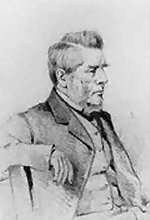Harry Powlett, 4th Duke of Cleveland
| His Grace The Duke of Cleveland KG | |
|---|---|
|
The Duke of Cleveland. | |
| Personal details | |
| Born | 19 April 1803 |
| Died |
21 August 1891 (aged 88) Cleveland House, 16 St James's Square, Westminster, London |
| Nationality | British |
| Political party | Whig |
| Spouse(s) | Lady Catherine Stanhope (1819–1901) |
| Alma mater | Oriel College, Oxford |

Harry George Powlett, 4th Duke of Cleveland KG (19 April 1803 – 21 August 1891), styled The Honourable Harry Vane until 1827 and Lord Harry Vane from 1827 to 1864, who in 1864 adopted by Royal Licence the surname and arms of Powlett in lieu of Vane, was an English landowner, diplomat and Whig statesman. During the crisis which led to the collapse of Lord Russell's government in 1866 over the question of parliamentary reform, he was considered a possible compromise Prime Minister in a Whig-Conservative anti-reform coalition government, but such plans came to nothing.
Origins
Vane was the third son of William Vane, 1st Duke of Cleveland KG (1766–1842), by his wife Lady Catherine Margaret Powlett, daughter of Admiral Harry Powlett, 6th Duke of Bolton (1720–1794). His elder brothers were Henry Vane, 2nd Duke of Cleveland KG (1788–1864), and William Vane, 3rd Duke of Cleveland (1792–1864).
Career
Vane was educated at Oriel College, Oxford.[2] He entered the foreign service and held posts in Paris and Stockholm before entering the House of Commons in 1841 as a Member of Parliament for South Durham, which seat he held until 1859,[2][3] when he switched to Hastings, which he represented until his accession to the dukedom and elevation to the House of Lords on the death of his brother on 6 September 1864.[2][4] On 18 November 1864 he adopted by Royal Licence the surname and arms of Powlett in lieu of his patronymic, in accordance with the will of his maternal grandmother the Duchess of Bolton (Katherine Lowther (d.1809), daughter of Robert Lowther, sister of James Lowther, 1st Earl of Lonsdale, and wife of the 6th Duke of Bolton).[5] He was made a Knight of the Garter in 1865.[6] During the crisis which led to the collapse in 1866 of Lord Russell's second ministry over the question of parliamentary reform, he was considered a possible compromise Prime Minister in a Whig-Conservative anti-reform coalition government, but such plans came to nothing.[7]
Marriage
At Chevening on 2 August 1854, Vane married Lady Dalmeny (1819–1901), the daughter of Philip Henry Stanhope, 4th Earl Stanhope and widow of Archibald Primrose, Lord Dalmeny, by whom she was the mother of Archibald Primrose, 5th Earl of Rosebery, Prime Minister of the United Kingdom. The marriage was without progeny.
Mistress
Although Cleveland had no legitimate progeny, he produced an illegitimate daughter by his mistress Mary Ann Raby. The daughter was called Charlotte (Lottie) Raby (1841–1919) and took the surname Raby so her parentage was not discovered.
Death and succession
Cleveland died in August 1891, aged 88, at his London townhouse Cleveland House, 16 St James's Square, Westminster, London.[2] Thereupon the line of succession to his peerages became unclear. In 1891 the Committee of Privileges of the House of Lords declared the title of Duke of Cleveland extinct but declared Henry de Vere Vane to be the rightful heir of the title Baron Barnard and to the estates of Raby Castle and Barnard Castle, which latter had been purchased in 1626 by the Vane family.[8]
Ancestry
| Ancestors of Harry Powlett, 4th Duke of Cleveland | |||||||||||||||||||||||||||||||||||||||||||||||||||||||||||||||||||||||||||||||||||||||||||||||||||||||||||||||||||||||||||||||||||||||||||||||||||||||||||||||||||||||||||||||||||||||||||||||||||||||||||||||||||||||||||||||||||||||||||||||||||||||||||||||||||||||||||||||||||||||||||||||||||||||||||||||||||||||||||||||||||||||||||||||||||||||||||||||||||||||||||||||||||||||||||||||||||||||||||||||||||||||||||||||||||||||||||||||||||||||||||||||||||||||||||||||||||||||||||||||||||||||||||||||||||||||
|---|---|---|---|---|---|---|---|---|---|---|---|---|---|---|---|---|---|---|---|---|---|---|---|---|---|---|---|---|---|---|---|---|---|---|---|---|---|---|---|---|---|---|---|---|---|---|---|---|---|---|---|---|---|---|---|---|---|---|---|---|---|---|---|---|---|---|---|---|---|---|---|---|---|---|---|---|---|---|---|---|---|---|---|---|---|---|---|---|---|---|---|---|---|---|---|---|---|---|---|---|---|---|---|---|---|---|---|---|---|---|---|---|---|---|---|---|---|---|---|---|---|---|---|---|---|---|---|---|---|---|---|---|---|---|---|---|---|---|---|---|---|---|---|---|---|---|---|---|---|---|---|---|---|---|---|---|---|---|---|---|---|---|---|---|---|---|---|---|---|---|---|---|---|---|---|---|---|---|---|---|---|---|---|---|---|---|---|---|---|---|---|---|---|---|---|---|---|---|---|---|---|---|---|---|---|---|---|---|---|---|---|---|---|---|---|---|---|---|---|---|---|---|---|---|---|---|---|---|---|---|---|---|---|---|---|---|---|---|---|---|---|---|---|---|---|---|---|---|---|---|---|---|---|---|---|---|---|---|---|---|---|---|---|---|---|---|---|---|---|---|---|---|---|---|---|---|---|---|---|---|---|---|---|---|---|---|---|---|---|---|---|---|---|---|---|---|---|---|---|---|---|---|---|---|---|---|---|---|---|---|---|---|---|---|---|---|---|---|---|---|---|---|---|---|---|---|---|---|---|---|---|---|---|---|---|---|---|---|---|---|---|---|---|---|---|---|---|---|---|---|---|---|---|---|---|---|---|---|---|---|---|---|---|---|---|---|---|---|---|---|---|---|---|---|---|---|---|---|---|---|---|---|---|---|---|---|---|---|---|---|---|---|---|---|---|---|---|---|---|---|---|---|---|---|---|---|---|---|---|---|---|---|---|---|---|---|---|---|---|---|---|---|---|---|---|---|---|---|---|---|---|---|---|---|---|---|---|---|---|---|---|---|---|---|---|---|---|---|---|---|---|---|---|---|---|---|---|---|---|---|---|---|---|---|---|---|---|---|---|---|---|---|---|---|---|---|---|---|---|---|---|---|---|---|---|---|---|---|---|---|---|---|---|---|---|---|---|---|---|---|---|---|---|
| |||||||||||||||||||||||||||||||||||||||||||||||||||||||||||||||||||||||||||||||||||||||||||||||||||||||||||||||||||||||||||||||||||||||||||||||||||||||||||||||||||||||||||||||||||||||||||||||||||||||||||||||||||||||||||||||||||||||||||||||||||||||||||||||||||||||||||||||||||||||||||||||||||||||||||||||||||||||||||||||||||||||||||||||||||||||||||||||||||||||||||||||||||||||||||||||||||||||||||||||||||||||||||||||||||||||||||||||||||||||||||||||||||||||||||||||||||||||||||||||||||||||||||||||||||||||
References
- ↑ Debrett's Peerage, 1968, p. 115, which omits appaumée, useful in differentiating from Fane arms; concerning appaumée Cussans (1898) states: "In blazoning a Hand, besides stating what position it occupies, and whether it be the dexter or sinister, and erased or couped, it must be mentioned whether it be clenched or appaumé". (Cussans, John, Handbook of Heraldry, 2nd Edition, London, 1868, p. 47 , p. 92).
- 1 2 3 4 thepeerage.com Harry George Powlett, 4th Duke of Cleveland
- ↑ Leigh Rayment's Historical List of MPs – Constituencies beginning with "D" (part 4)
- ↑ Leigh Rayment's Historical List of MPs – Constituencies beginning with "H" (part 2)
- ↑ The London Gazette: no. 22915. p. 5797. 25 November 1864.
- ↑ The London Gazette: no. 22958. p. 2040. 14 April 1865.
- ↑ Blake, Robert (1966). Disraeli. New York: St. Martin's Press. ISBN 0-19-832903-2. OCLC 8047., p. 439.
- ↑ The Official Gazette of the Provincial Grand Lodge of Durham 1908 to 1919. Durham Freemasons. 1919. p. 172.
External links
| Wikimedia Commons has media related to Harry Powlett, 4th Duke of Cleveland. |
- Hansard 1803–2005: contributions in Parliament by the Duke of Cleveland
| Parliament of the United Kingdom | ||
|---|---|---|
| Preceded by John Bowes Joseph Pease |
Member of Parliament for South Durham 1841–1859 With: John Bowes 1841–1847 James Farrer 1847–1857 Henry Pease 1857–1859 |
Succeeded by Henry Pease James Farrer |
| Preceded by Frederick North Patrick Francis Robertson |
Member of Parliament for Hastings 1859–1864 With: Frederick North |
Succeeded by Frederick North George Waldegrave-Leslie |
| Peerage of the United Kingdom | ||
| Preceded by William Vane |
Duke of Cleveland 1864–1891 |
Succeeded by Extinct |
| Peerage of England | ||
| Preceded by William Vane |
Baron Barnard 1864–1891 |
Succeeded by Henry Vane |
